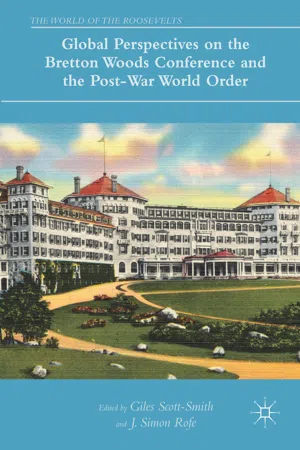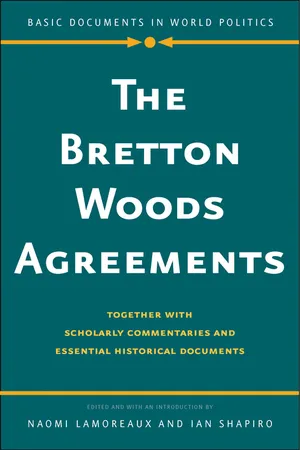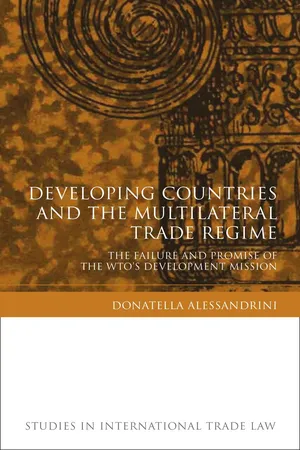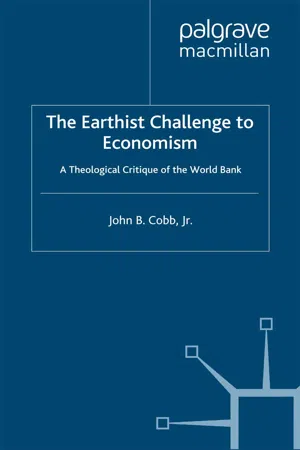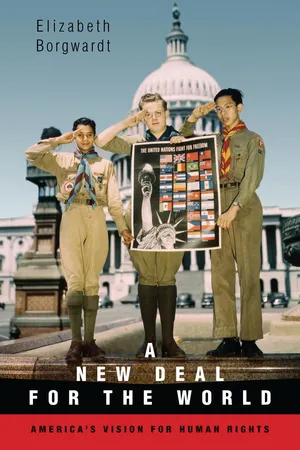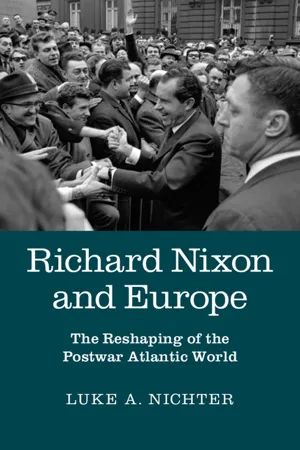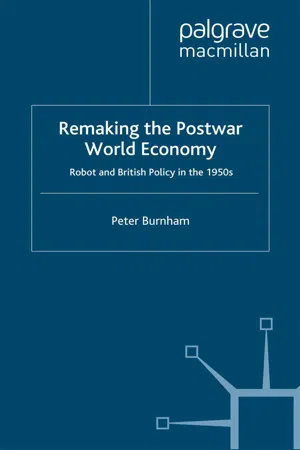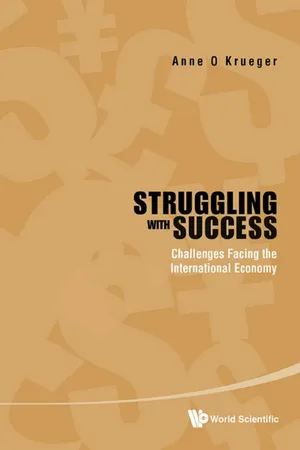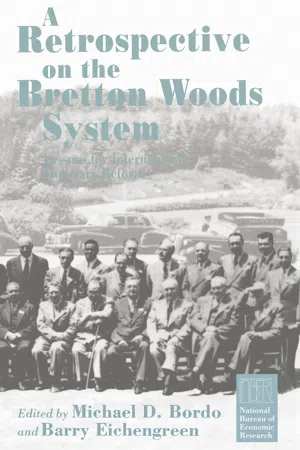Politics & International Relations
Bretton Woods Conference
The Bretton Woods Conference, held in 1944, established the framework for the post-World War II international monetary system. It led to the creation of the International Monetary Fund (IMF) and the World Bank, with the goal of promoting global economic stability and development. The agreements made at Bretton Woods set the stage for economic cooperation and financial regulation among participating nations.
Written by Perlego with AI-assistance
Related key terms
1 of 5
11 Key excerpts on "Bretton Woods Conference"
- Giles Scott-Smith, J. Simon Rofe, Giles Scott-Smith, J. Simon Rofe(Authors)
- 2017(Publication Date)
- Palgrave Macmillan(Publisher)
1 CHAPTER 1 Bretton Woods: A Global Perspective Giles Scott-Smith and J. Simon Rofe The United Nations Monetary and Financial Conference was held at the Mount Washington Hotel, Bretton Woods, New Hampshire, from July 1–22, 1944. The conference laid out the basic rules and regulations for the management of global finance in the postwar world economy. The conference paved the way for the International Monetary Fund (IMF), the International Bank for Reconstruction and Development (World Bank), and (via the failed negotiations for an International Trade Organization) what would soon become the General Agreements on Tariffs and Trade. It was an event of unparalleled multilateral negotia- tion, involving 730 delegates from 44 nations for three weeks of intense interaction. Yet up till now the Bretton Woods experience of the majority of those nations has been ignored as a sideshow. This volume fills that gap by exploring the historical record of these multiple perspectives, in doing so providing the basis for a more comprehensive analysis of Bretton Woods as a seminal moment of multilateral diplomacy in inter- national history. © The Author(s) 2017 G. Scott-Smith and J.S. Rofe (eds.), Global Perspectives on the Bretton Woods Conference and the Post-War World Order, The World of the Roosevelts, DOI 10.1007/978-3-319-60891-4_1 G. Scott-Smith (*) Leiden University Institute of History, Leiden, The Netherlands J.S. Rofe SOAS University of London, London, England 2 G. SCOTT-SMITH AND J. S. ROFE Bretton Woods produced a set of agreements that laid the basis for the global economy in the postwar era. Alongside the rules, governance structure and funding arrangements for the IMF and the World Bank, it fixed the value of the US$ to $35 for an ounce of gold, creating a fixed point around which all other currencies could orientate.- eBook - PDF
Bretton Woods Agreements
Together with Scholarly Commentaries and Essential Historical Documents
- Naomi Lamoreaux, Ian Shapiro(Authors)
- 2019(Publication Date)
- Yale University Press(Publisher)
1 O n July 1 , 1944 , less than a month after the D-Day landings in Normandy, delegates from forty-four nations gathered at a sprawling hotel near the base of Mount Washington in Bretton Woods, New Hampshire, to plan the postwar financial order. As the delegates debated the arcane details of a sys-tem of fixed but flexible exchange rates, Allied troops fought their way through France and battled island by island across the Pacific. US forces were sustaining heavy casualties on Guam when the conference ended three weeks later with agreement on two accords. One accord created the International Monetary Fund (IMF), and the other the International Bank for Reconstruc-tion and Development (IBRD), progenitor of the World Bank. The contrast between the life-and-death struggles of the war and the eso-teric debates at the conference could not have been starker. At stake in both, however, was the kind of world that would take shape in the aftermath of the fighting. The battles determined which side would get the chance to re-make the world, and by July of 1944 it was clear that victory would go to the Allies. But what the postwar world would look like was yet to be determined. The Bretton Woods accords, reproduced at the end of this volume, were part of the answer. The essays we have collected here revisit the accords, dry and opaque as they might seem at first glance to be, with the aim of recapturing the fears and tensions that shaped their provisions. The essays also examine alternative proposals that the assembly might have adopted, ideas whose time had passed or were yet to come. Dominated by the United States, the conference left many problems unresolved, many countries’ needs unmet, and these omissions would lead to the eventual collapse of the system. The fate of the Bretton Woods accords, the essays show, was as much bound up with what was not accomplished as with what was. - eBook - PDF
Developing Countries and the Multilateral Trade Regime
The Failure and Promise of the WTO's Development Mission
- Donatella Alessandrini(Author)
- 2010(Publication Date)
- Hart Publishing(Publisher)
In order to support its expanding productive capacity, the US needed to find new markets abroad in which to place its products, invest its surplus capital and access cheap sources of raw materials. 45 In order for the US to secure access to the markets of the soon-to-be developing countries, the participation of the latter in its plans for a new world order was crucial. Thus, the initiative for a postwar international order was taken by the US. Two major conferences were held in the 1940s. The Dumbarton Oaks Conference was to give birth to the postwar interna-tional political institution, namely the United Nations (UN), which, established in 1945, was to be the successor of the League of Nations. 46 The Bretton Woods Conference of 1944 dealt with the establishment of the 41 Arrighi (n 1) 59. Arrighi is arguing that the absence of territorialism abroad was due to the unprecedented territorialism at home. Whereas ‘ British capitalism and territorialism had cross-fertilized one another … US capitalism and territorialism were indistinguishable from one another’. Ibid . 42 Ibid . 43 Ibid 61. 44 Ibid 62. 45 See A Escobar, Encountering Development: The Making and Unmaking of the Third World (Princeton, Princeton University Press, 1995) 32–33. 46 See HG Nicholas, The United Nations as a Political Institution 5th edn (Oxford, Oxford University Press, 1975) 1–13. 24 The Bretton Woods Conference postwar international economic institutions. The International Monetary Fund (IMF) would be in charge of assisting countries experiencing short-term financial difficulties; the International Bank for Reconstruction and Development (IBRD), which later became part of the World Bank (WB), was to administer postwar reconstruction loans; and the ITO was to shape the international commercial environment. 47 Thus, the Bretton Woods Conference and the Dumbarton Oaks Confer-ence institutionalised an important separation between public and eco-nomic international law. - eBook - PDF
The Earthist Challenge to Economism
A Theological Critique of the World Bank
- J. Cobb, Kenneth A. Loparo, Shivesh C. Thakur(Authors)
- 1998(Publication Date)
- Palgrave Macmillan(Publisher)
4 The Bretton Woods Institutions I. BRETTON WOODS The economistic age was ushered in at Bretton Woods, New Hampshire, in 1944. While most of the world's attention was directed to the establishment of the United Nations, the actions taken at Bretton Woods would prove, in the long run, more fateful. These actions were about the organization of the global economic order. At the time, and for some years thereafter, the great import- ance of the work of Bretton Woods was not apparent. It seemed technical and narrowly focused in a world whose problems were enormous and basic. Bretton Woods was only tangentially concerned with recovery from the vast destruc- tion caused by World War II. Its emphasis was on the more distant future, on what would happen after normalcy had returned. Nevertheless, there was at Bretton Woods a sense of inaug- urating something new, something of sacred worth. In his speech moving to accept the Final Act, John Maynard Keynes marveled that representatives of 44 nations had worked together so well. He concluded: 'If we can so continue, this nightmare in which most of us here present have spent too much of our lives will be over. The brotherhood of man will have become more than a phrase.' 1 Keynes' special interest was in the World Bank. He 'never ceased to claim that this unprecedented Bank could do no less than help to remake the world in a finer image and contribute to the brotherhood of man.' 2 That the goal of Bretton Woods was to introduce a new age in which the mistakes of the old would not recur was clear in the speech of US Treasury Secretary, Henry Morgenthau. 'All of us have seen the great economic tragedy of our time. We saw the worldwide depression of the 1930s. We saw currency disorders develop and spread from land to land, destroying the basis for international trade and international investment 61 62 The Earthist Challenge to Economism and even international faith. - eBook - ePub
A New Deal for the World
America’s Vision for Human Rights
- Elizabeth Borgwardt(Author)
- 2007(Publication Date)
- Belknap Press(Publisher)
The memory of the unsuccessful 1933 London Economic Conference, where President Roosevelt had emphatically abandoned multilateralism generally, served as a cautionary tale for the Bretton Woods delegates: “Looking back on that unhappy episode, it seems to have been caused primarily by divided counsel within the Administration and sloppy preparation,” wrote Acheson, “which obscured for both the President and the Secretary [of State] the relation between the foreign and domestic issues involved and the essential connection between foreign trade policy and international monetary arrangements.” But eleven years later, in 1944, “these issues had been resolved, and brilliant results were achieved at the International Monetary Conference at Bretton Woods.” 23 By the end of the 1930s, it was a truism that turning one’s back on the international economy would have unfavorable domestic repercussions. Wartime planners in the United States accordingly tried to see whether policymakers could develop “some system of organized international relations” not only to maintain postwar peace and security, but also to “promote the general welfare,” as former State Department official Ruth Russell explained in her magisterial history of the United Nations Charter. As Republican presidential candidate Wendell Willkie wrote in his runaway bestseller, One World, the flawed World War I settlement did not “sufficiently seek solution to the economic problems of the world. Its attempts to solve the world’s problems were primarily political - eBook - PDF
Richard Nixon and Europe
The Reshaping of the Postwar Atlantic World
- Luke A. Nichter(Author)
- 2015(Publication Date)
- Cambridge University Press(Publisher)
Nixon’s blueprint to end Bretton Woods was part of a broader, more isolationist economic policy consistent with the Nixon Doctrine, which said that Europeans should take greater responsibility for their own needs. 36 The collapse of the system marked the end of the postwar era 1 and of the golden age of capitalism itself, in which American gold and economic assistance were prerequisites to European recovery following World War II. The Bretton Woods system was set up during an economic conference attended by forty-four nations and held at Bretton Woods, New Hampshire, July 1–22, 1944. 2 John Maynard Keynes and Harry Dexter White drafted the proposals beginning in 1941 that would form the basis of Bretton Woods. Negotiations on these proposals began during September 1943 and were capped by a summit at Atlantic City in June 1944. 3 The final act of the Bretton Woods Conference, signed on July 22, created the International Monetary Fund (IMF) and the International Bank for Reconstruction and Development (later the World Bank). In addition, the conference set up a new world currency system of gold-based “fixed but moveable” exchange rates. 4 Adjustments to the system were supposed to be made in consultation with the IMF. This system stood in contrast to the rigid interwar “pure gold” exchange rate system that had contributed to the Great Depression because its inflexibility inhibited central bankers from taking necessary action to expedite economic recovery. 5 Bretton Woods was a welcome transition that returned 1 The early 1970s is also where Eric Hobsbawm subdivides his Age of Extremes; the postwar era came to an end due to the economic and social crises of the early 1970s. Tony Judt, in Postwar: A History of Europe since 1945, uses a similar periodization. See the discussion in Hartmut Marhold, “How to Tell the History of European Integration in the 1970s: A Survey of the Literature and Some Proposals,” L’Europe en formation no. - eBook - PDF
Remaking the Postwar World Economy
Robot and British Policy in the 1950s
- P. Burnham(Author)
- 2003(Publication Date)
- Palgrave Macmillan(Publisher)
1 Britain, Bretton Woods and the Crisis of the World Economy, 1945-1951 I Introduction For most scholars working in the field of international political economy (IPE), the 1950s is a forgotten decade. Sandwiched between the well-trawled period of postwar reconstruction (1945-51) and the so-called 'golden age' of the 1960s, the decade is seen almost exclusively through the lens of the Suez crisis, the Treaty of Rome and the consolidation of bipolar Cold War politics. There has been relatively little academic interest in charting the development of international economic relations in the 1950s, and this is particularly true with respect to international monetary policy. As a result, most IPE studies tend to assume that during this period the world economy was governed by the rules and institutions established in accordance with the Bretton Woods Agreement of 1944. Although it is often pointed out that the practice of the 'system' diverged from the theory of its founders, it is nevertheless a cardinal assumption of the discipline (and of political science and international relations more generally) that Bretton Woods operated quietly and effectively in the 1950s to usher in a period of unrivalled growth and prosperity in the world economy. 1 This study shows, however, that there is little evidence to support this assumption. The inauguration of the IMF and the International Bank at Savannah, Georgia in March 1946, was followed not by the smooth unfolding of 'embedded liberalism', 2 but by waves of economic crisis which forced the 'system' to shut down in August 1947. The multilateral ideals of Keynes and White were sidelined as European economies were kick-started by dollar aid in a world context dominated by discriminatory blocs and bilateral trade and payments agreements. By 1951, as the consequences of Korean rear- mament began to bite, the world economy faced its most severe postwar test. The Bretton Woods institutions were dormant and currencies incon- vertible. - eBook - PDF
Struggling With Success: Challenges Facing The International Economy
Challenges Facing the International Economy
- Anne O Krueger(Author)
- 2012(Publication Date)
- World Scientific(Publisher)
10 Events leading to the Bank and the Fund . Discussions for international monetary arrangements culminated in the Bretton Woods Conference of 1944, with participation by representatives of 45 countries. 11 Although it seems clear from all accounts that it was agreed that there would be three international institutions — to oversee trade arrangements, 12 the international monetary system, and to supplement private long term cap-ital flows — only the International Monetary Fund and the IBRD Articles were drawn up and approved at Bretton Woods. Proposals for the international monetary facility were considerably more controversial between the Americans and the British. 13 As is well known, Keynes initially proposed an international bank-money, called “bancor”. The proposal focussed upon increasing world liquidity, and assumed that exchange controls and quantitative restrictions would persist in the interna-tional economy. The clearing union would be one in which members had virtually automatic drawing rights (like overdrafts), up to some specified limit. This proposal was firmly grounded in the Keynesian view of a world in which secular stagnation would be the chief problem and the solution would involve measures to stimulate demand. He therefore also initially proposed that a sig-nificant part of the adjustment of any payments imbalance be placed on the surplus country. 14 Bretton Woods Institutions: A View from the 1990s 221 10 See Moggridge (1992, pp. 676ff). 11 These “countries” included India as well as representatives of countries then under German rule. See James (1996), p. 48 for a listing. 12 Agreements with regard to trading arrangements were a part of the lend-lease agreements, providing for recovery plans to include movement toward “the elimination of all forms of dis-criminatory treatment in international commerce; to the reduction of tariffs and any other trade barriers”. - eBook - PDF
Monetary War and Peace
London, Washington, Paris, and the Tripartite Agreement of 1936
- Max Harris(Author)
- 2021(Publication Date)
- Cambridge University Press(Publisher)
10 From Bretton Woods to Today Successful though the Tripartite Agreement was in putting an end to the monetary chaos of the early 1930s, it could not survive the demands of total war. Soon after Britain and France imposed exchange controls with the outbreak of the Second World War, it became an agreement in name only and then faded from view. Policymakers were intent, however, on avoiding a relapse to the economic conflagration of the 1930s and began planning for a postwar world early on in the conflict. These efforts culminated in the 1944 conference at Bretton Woods, where the allies established the International Monetary Fund (IMF), World Bank, and a system of fixed-but-adjustable exchange parities. Ever since, Bretton Woods has become the key landmark of international monetary cooper- ation, forming the historical backdrop for policymakers today. The Tripartite Agreement, on the other hand, is largely forgotten, product of a decade whose lessons many assume to be only in the negative. Yet the Agreement’s principles live on, embedded in so much of the postwar push for collaboration. The sentiments articulated in those five paragraphs of September 1936 – refrain from competitive depreciation, work toward exchange stability, avoid exchange control, consult and inform – reappear time and again, from the IMF’s Articles of Agreement in 1944 to G20 communiqués today. 1 In fact, the Tripartite Agreement first recognized the dual concept that countries should not sacrifice their domestic economies just to maintain their exchange rates but neither should they ignore the effect of their international monetary actions on 1 For instance, the July 2013 G20 communiqué of finance ministers and central bank governors declared, “We will refrain from competitive devaluation and will not target our exchange rates for competitive purposes. We will resist all forms of protectionism and keep our markets open” (Group of Twenty 2013). 233 - eBook - PDF
A Retrospective on the Bretton Woods System
Lessons for International Monetary Reform
- Michael D. Bordo, Barry Eichengreen, Michael D. Bordo, Barry Eichengreen(Authors)
- 2007(Publication Date)
- University of Chicago Press(Publisher)
The drive all around was a return, in the broad essentials, to laissez faire” (Hansen 1945, 199). By 5. These authors emphasize convergence of conceptual frameworks as a determinant of coop- eration, but they provide different stones of how such convergence does or does not take place. 161 The Political Origins of Bretton Woods the late 1930s, Hansen argued, all this had changed. A new social purpose infused postwar planning the second time around. Understanding how this “new thinking” got established and shaped government policy and the Anglo- American agreement is our task. 3.2 The Emergence of an International Policy Community The Bretton Woods agreement is often seen as the result of the ideas and diplomacy of John Maynard Keynes and Harry Dexter White.6 Indeed, these economists, particularly Keynes, were pivotal figures in devising monetary plans, and they led their delegations in the celebrated Anglo-American nego- tiations during the war. But they were also part of a larger collection of econ- omists and policy specialists who were located in the British and American Treasury Departments, in other government offices, and in universities and policy institutions. While many of the beliefs held by this loose community of specialists reflected the evolving views of professional economists, the community itself was given form by the demands of British and American governments to deliberate on postwar economic matters. The process of post- war planning on both sides of the Atlantic served to organize and stimulate the activities of these policy specialists. We can trace the contours of this assemblage of experts and situate it within the larger institutions of British and American government. - eBook - PDF
- R. P. Barston(Author)
- 2019(Publication Date)
- Routledge(Publisher)
Chapter 9 International financial relationsInternational financial relationsInternational financial relations Within the past decade, questions to do with international financial relations have increasingly moved to the forefront of the international agenda. A noticeable feature of this development is the rise in importance of the IMF and the IBRD as international institutions responsible for the coordination and management of international liquidity and develop- ment finance. This chapter explores two areas: the main developments in the organisation and work of the IMF since 1973 and the management of the international debt crisis, including the role of the IMF. 1 Historical background The IMF and the World Bank were formally set up on 27 December 1945, following the Bretton Woods Conference, attended by 44 countries. 2 Bret- ton Woods in fact was one of several major conferences held during the closing stages of the Second World War on the establishment of post-war institutions, including the UN conferences on food and agriculture at Hot Springs, Virginia, in May 1943, which culminated in the San Francisco conference of April 1945 that set up the United Nations. The Havana Charter, which was intended to establish an international trade organi- sation (ITO) to complement the IMF and the Bank, was, however, never ratified. It was not until 1947 that a much reduced version of an ITO in the form of the General Agreement on Tariffs and Trade (GATT) was established at Geneva. The framing and drafting of the Bretton Woods agreements were strongly influenced by the wartime setting and the need to prevent the recurrence of a collapse of the international monetary system similar to that of the 1930s. 3 The themes of reconstruction and the transition from a wartime to a peacetime international economy dominated the original conception of the IMF and the Bank. In this respect, too, the original conception of the Bank was weighted in favour of the reconstruction of
Index pages curate the most relevant extracts from our library of academic textbooks. They’ve been created using an in-house natural language model (NLM), each adding context and meaning to key research topics.
